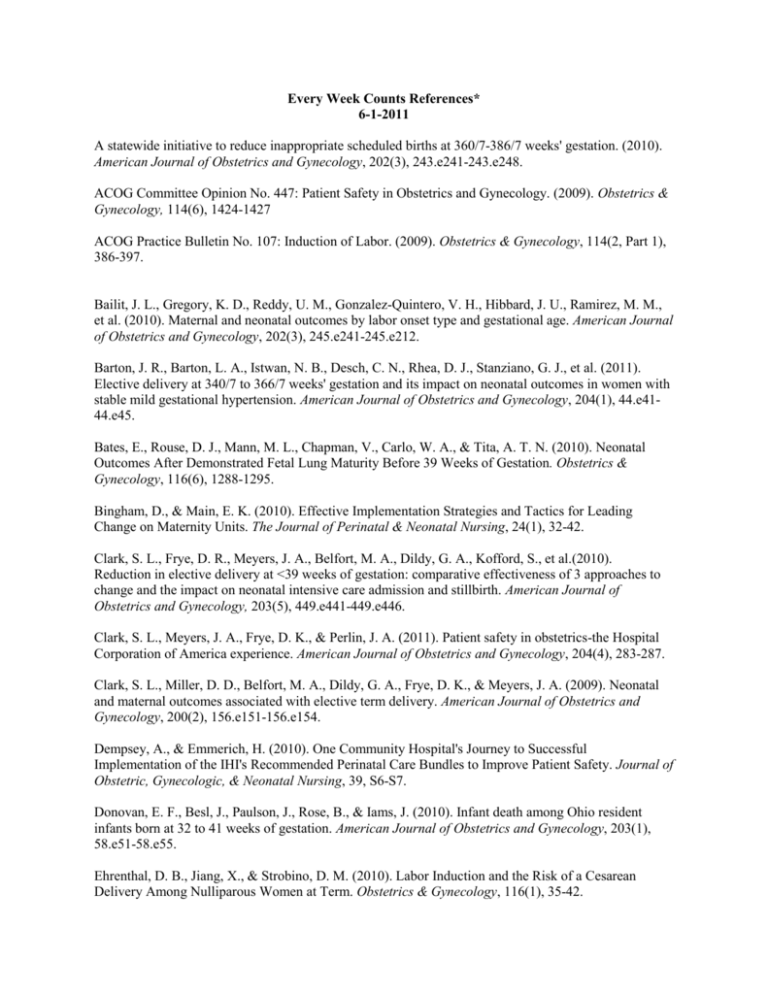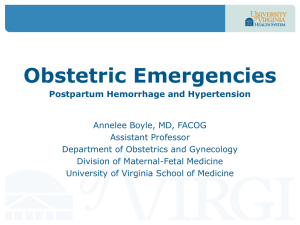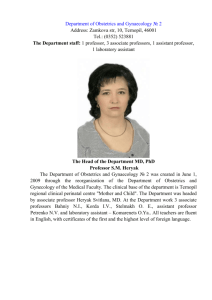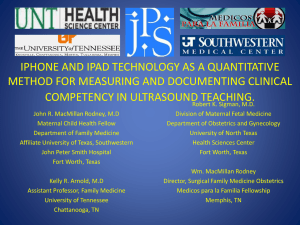Every Week Counts References* 6-1-2011 A statewide initiative to
advertisement

Every Week Counts References* 6-1-2011 A statewide initiative to reduce inappropriate scheduled births at 360/7-386/7 weeks' gestation. (2010). American Journal of Obstetrics and Gynecology, 202(3), 243.e241-243.e248. ACOG Committee Opinion No. 447: Patient Safety in Obstetrics and Gynecology. (2009). Obstetrics & Gynecology, 114(6), 1424-1427 ACOG Practice Bulletin No. 107: Induction of Labor. (2009). Obstetrics & Gynecology, 114(2, Part 1), 386-397. Bailit, J. L., Gregory, K. D., Reddy, U. M., Gonzalez-Quintero, V. H., Hibbard, J. U., Ramirez, M. M., et al. (2010). Maternal and neonatal outcomes by labor onset type and gestational age. American Journal of Obstetrics and Gynecology, 202(3), 245.e241-245.e212. Barton, J. R., Barton, L. A., Istwan, N. B., Desch, C. N., Rhea, D. J., Stanziano, G. J., et al. (2011). Elective delivery at 340/7 to 366/7 weeks' gestation and its impact on neonatal outcomes in women with stable mild gestational hypertension. American Journal of Obstetrics and Gynecology, 204(1), 44.e4144.e45. Bates, E., Rouse, D. J., Mann, M. L., Chapman, V., Carlo, W. A., & Tita, A. T. N. (2010). Neonatal Outcomes After Demonstrated Fetal Lung Maturity Before 39 Weeks of Gestation. Obstetrics & Gynecology, 116(6), 1288-1295. Bingham, D., & Main, E. K. (2010). Effective Implementation Strategies and Tactics for Leading Change on Maternity Units. The Journal of Perinatal & Neonatal Nursing, 24(1), 32-42. Clark, S. L., Frye, D. R., Meyers, J. A., Belfort, M. A., Dildy, G. A., Kofford, S., et al.(2010). Reduction in elective delivery at <39 weeks of gestation: comparative effectiveness of 3 approaches to change and the impact on neonatal intensive care admission and stillbirth. American Journal of Obstetrics and Gynecology, 203(5), 449.e441-449.e446. Clark, S. L., Meyers, J. A., Frye, D. K., & Perlin, J. A. (2011). Patient safety in obstetrics-the Hospital Corporation of America experience. American Journal of Obstetrics and Gynecology, 204(4), 283-287. Clark, S. L., Miller, D. D., Belfort, M. A., Dildy, G. A., Frye, D. K., & Meyers, J. A. (2009). Neonatal and maternal outcomes associated with elective term delivery. American Journal of Obstetrics and Gynecology, 200(2), 156.e151-156.e154. Dempsey, A., & Emmerich, H. (2010). One Community Hospital's Journey to Successful Implementation of the IHI's Recommended Perinatal Care Bundles to Improve Patient Safety. Journal of Obstetric, Gynecologic, & Neonatal Nursing, 39, S6-S7. Donovan, E. F., Besl, J., Paulson, J., Rose, B., & Iams, J. (2010). Infant death among Ohio resident infants born at 32 to 41 weeks of gestation. American Journal of Obstetrics and Gynecology, 203(1), 58.e51-58.e55. Ehrenthal, D. B., Jiang, X., & Strobino, D. M. (2010). Labor Induction and the Risk of a Cesarean Delivery Among Nulliparous Women at Term. Obstetrics & Gynecology, 116(1), 35-42. Fisch, J. M., English, D., Pedaline, S., Brooks, K., & Simhan, H. N. (2009). Labor Induction Process Improvement: A Patient Quality-of-Care Initiative. Obstetrics & Gynecology, 113(4), 797-803. Fleischman, A. R., Oinuma, M., & Clark, S. L. (2010). Rethinking the Definition of "Term Pregnancy". Obstetrics & Gynecology, 116(1), 136-139. Glantz, J. C. (2010). Term Labor Induction Compared With Expectant Management. Obstetrics & Gynecology, 115(1), 70-76. Goldenberg, R. L., McClure, E. M., Bhattacharya, A., Groat, T. D., & Stahl, P. J. (2009). Women’s Perceptions Regarding the Safety of Births at Various Gestational Ages. Obstetrics & Gynecology, 114(6), 1254-1258. Hanley, G. E., Janssen, P. A., & Greyson, D. (2010). Regional Variation in the Cesarean Delivery and Assisted Vaginal Delivery Rates. Obstetrics & Gynecology, 115(6), 1201-1208. Holm, L. D. (2009). Provider documentation and elective induction of labor: a 6-month experience at a university medical center. American Journal of Obstetrics and Gynecology, 200(3), 336.e331-336.e335. Kamath, B. D., Marcotte, M. P., & Defranco, E. A. Neonatal Morbidity after Documented Fetal Lung Maturity in Late Preterm and Early Term Infants. American Journal of Obstetrics and Gynecology. Article in Press, Accepted Manuscript. Kamath, B. D., Todd, J. K., Glazner, J. E., Lezotte, D., & Lynch, A. M. (2009). Neonatal Outcomes After Elective Cesarean Delivery. Obstetrics & Gynecology, 113(6), 1231-1238. Knox, G. E., & Simpson, K. R. (2011). Perinatal high reliability. American Journal of Obstetrics and Gynecology, 204(5), 373-377. Laughon, S. K., Reddy, U. M., Sun, L., & Zhang, J. (2010). Precursors for Late Preterm Birth in Singleton Gestations. Obstetrics & Gynecology, 116(5), 1047-1055. Lewis, J. A. (2009). Assessing the Effects of Age, Gestation, Socioeconomic Status, and Ethnicity on Labor Inductions. MCN: The American Journal of Maternal/Child Nursing, 34(1), 70 Macones, G. A. (2010). Elective delivery before 39 weeks: reason for caution. American Journal of Obstetrics and Gynecology, 202(3), 208. Moleti, C. A. (2009). Trends and Controversies in Labor Induction. MCN: The American Journal of Maternal/Child Nursing, 34(1), 40-47. Murthy, K., Grobman, W. A., & Holl, J. (2011). National trends in induction of labor at late preterm gestations. American Journal of Obstetrics and Gynecology, 204(1, Supplement 1), S233-S233. Murthy, K., Grobman, W. A., Lee, T. A., & Holl, J. L. (2011). Trends in induction of labor at early-term gestation. American Journal of Obstetrics and Gynecology, 204(5), 435.e431-435.e436. Oshiro, B. T., Henry, E., Wilson, J., Branch, D. W., Varner, M. W., & for the Women and Newborn Clinical Integration, P. (2009). Decreasing Elective Deliveries Before 39 Weeks of Gestation in an Integrated Health Care System. Obstetrics & Gynecology, 113(4), 804-811. Osmundson, S. M. D., Ou-Yang, R. J. M. D., & Grobman, W. A. M. D. M. B. A. (2011). Elective Induction Compared With Expectant Management in Nulliparous Women With an Unfavorable Cervix. Obstetrics & Gynecology, 117(3), 583-587. Reddy, U. M., Bettegowda, V. R., Dias, T., Yamada-Kushnir, T., Ko, C.-W., & Willinger, M. (2011). Term Pregnancy: A Period of Heterogeneous Risk for Infant Mortality. Obstetrics & Gynecology, 117(6), 1279-1287. Reisner, D. P., Wallin, T. K., Zingheim, R. W., & Luthy, D. A. (2009). Reduction of elective inductions in a large community hospital. American Journal of Obstetrics and Gynecology, 200(6), 674.e671674.e677. Robinson, C. J., Villers, M. S., Johnson, D. D., & Simpson, K. N. (2010). Timing of elective repeat cesarean delivery at term and neonatal outcomes: a cost analysis. American Journal of Obstetrics and Gynecology, 202(6), 632.e631-632.e636. Signore, C. (2010). No Time for Complacency: Labor Inductions, Cesarean Deliveries, and the Definition of "Term". Obstetrics & Gynecology, 116(1), 4-6. Simpson, K. R. (2010). Quality Measures for Perinatal Care. MCN: The American Journal of Maternal/Child Nursing, 35(1), 64. Simpson, K. R. (2010). Reconsideration of the Costs of Convenience: Quality, Operational, and Fiscal Strategies to Minimize Elective Labor Induction. The Journal of Perinatal & Neonatal Nursing, 24(1), 43-52. Simpson, K. R., Newman, G., & Chirino, O. R. (2010). Patient Education to Reduce Elective Labor Inductions. MCN: The American Journal of Maternal/Child Nursing, 35(4), 188-194. Snyder, C. C., Wolfe, K. B., Loftin, R. W., Tabbah, S., Lewis, D. F., & Defranco, E. A. (2011). The influence of hospital type on induction of labor and mode of delivery. American Journal of Obstetrics and Gynecology, In Press, Accepted Manuscript. Tita, A. T. N., Landon, M. B., Spong, C. Y., Lai, Y., Leveno, K. J., Varner, M. W., et al. (2009). Timing of Elective Repeat Cesarean Delivery at Term and Neonatal Outcomes. New England Journal of Medicine, 360(2), 111-120. Tita, A. T. N., Wetta, L. A., Bates, E., Doss, A., & Erwin, J. L. (2010). Infant death among Ohio residents: Donovan et al. American Journal of Obstetrics and Gynecology, 203(1), 86-87. Wilmink, F. A., Hukkelhoven, C. W. P. M., Lunshof, S., Mol, B. W. J., van der Post, J. A. M., & Papatsonis, D. N. M. (2010). Neonatal outcome following elective cesarean section beyond 37 weeks of gestation: a 7-year retrospective analysis of a national registry. American Journal of Obstetrics and Gynecology, 202(3), 250.e251-250.e258. Zhang, J., Landy, H. J., Ware Branch, D., Burkman, R., Haberman, S., Gregory, K. D., et al. (2010). Contemporary Patterns of Spontaneous Labor With Normal Neonatal Outcomes. Obstetrics & Gynecology, 116(6), 1281-1287. Zhang, J., Troendle, J., Mikolajczyk, R., Sundaram, R., Beaver, J., & Fraser, W. (2010). The Natural History of the Normal First Stage of Labor. Obstetrics & Gynecology, 115(4), 705-710. Zhang, J., Troendle, J., Reddy, U. M., Laughon, S. K., Branch, D. W., Burkman, R., et al. (2010). Contemporary cesarean delivery practice in the United States. American journal of obstetrics and gynecology, 203(4), 326.e321-326.e310. *This list of references contains articles deemed relevant to the topic of early elective delivery from five journals (American Journal of Obstetrics & Gynecology, JOGNN, MCN, Obstetrics & Gynecology, and The Journal of Perinatal and Neonatal Nursing) from 1-1-2009 through 6-1-2011. It is not to be considered comprehensive; it is a tool for easily obtainable relevant articles for Every Week Counts hospital teams. Please contact Barbara O’Brien if you have questions or need assistance.




